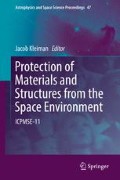Abstract
This paper deals with physical fundamentals of nanomaterial structure and properties, their classification and the peculiarities of different classes, and the main potential applications of these materials in the next generation spacecraft. Some results of the experimental and mathematical simulation of the space environment influence on nanostructures are given.
Access this chapter
Tax calculation will be finalised at checkout
Purchases are for personal use only
References
Kelsall RW, Hamley IW, Geoghegan M (eds) (2005) Nanoscale science and technology. Wiley, New York, NY
ISO/TS: 27687 (2008) Nanotechnologies—terminology and definitions for nano-objects. http://www.iso.org/iso/catalogue_detail.htm?csnumber=51240
ISO/TS 80004-1 (2010) Nanotechnologies—vocabulary. http://www.iso.org/iso/home/store/catalogue_ics/catalogue_detail_ics.htm?csnumber=68058
Lyakishev NP, Alymov MI (2006) Structural nanomaterials. Nanotech Russia 1(2):71–81 (in Russian)
Gogotsi Y (ed) (2006) Carbon nanomaterials. Taylor & Francis Group, Oxford
Gao B, Chen YF, Fuhrer MS et al (2005) Four-point resistance of individual single-wall carbon nanotubes. Phys Rev Lett 95:196802
Pop E, Mann D, Wang Q et al (2006) Thermal conductance of an individual single-wall carbon nanotube above room temperature. Nano Lett 6(1):96–100
Ghosh S, Calizo I, Teweldebrhan D et al (2008) Extremely high thermal conductivity of graphene. Appl Phys Lett 92(15):151911
Neto AHC, Novoselov KS (2011) New directions in science and technology: two-dimensional crystals. Rep Prog Phys 74:082501
Golberg D, Bando Y, Tang C, Zhi C (2007) Boron nitride nanotubes. Adv Mater 19:2413–2432
Novikov LS (1999) Contemporary state of spacecraft/environment interaction research. Radiat Meas 30:661–667
Watson KA, Connell JW (2006) Polymer and carbon nanotube composites for space applications. In: Dai L (ed) Carbon nanotechnology: recent developments in chemistry, physics, materials science and device applications. Elsevier, Amsterdam, pp 676–698
Baur J, Silverman E (2007) Challenges and opportunities in multifunctional nano-composite structures for aerospace applications. MRS Bull 32:328
Ackland G (2010) Controlling radiation damage. Science 327:1587–1588
Andrievskii RA (2010) Effect of irradiation on the properties of nanomaterials. Phys Metals Metallogr 110(3):229–240
Krasheninnikov AV, Nordlund K (2010) Ion and electron irradiation-induced effects in nano-structured materials. J Appl Phys 107:071301
Mohanty S, Ross R (eds) (2008) Multiscale simulation methods for nanomaterials. Wiley, New York, NY
Voronina EN, Novikov LS, Chernik VN et al (2012) Mathematical and experimental simulation of impact of atomic oxygen of the Earth’s upper atmosphere on nanostructures and polymer composites. Inorg Mater: Appl Res 3(2):95–101
Walker JG (1984) Satellite constellations. J Br Interplanet Soc 37:559–571
National Science and Technology Council (2004) Nanotechnology in space exploration. http://www.whitehouse.gov/files/docments/ostp/NSTC%20Reports/nni_space_exploration_rpt%202004.pdf
Ineke Malsch (ed) (2007) Nanotechnology in Aerospace 9th Nanoforum report. www.nanoforum.org. Accessed December 2014.
Meador MM et al (2010) NASA nanotechnology roadmap. Technology area 10. http://www.nasa.gov/pdf/501325main_TA10
Author information
Authors and Affiliations
Corresponding author
Editor information
Editors and Affiliations
Rights and permissions
Copyright information
© 2017 Springer International Publishing AG
About this paper
Cite this paper
Novikov, L.S., Voronina, E.N. (2017). Potential Space Applications of Nanomaterials. In: Kleiman, J. (eds) Protection of Materials and Structures from the Space Environment. Astrophysics and Space Science Proceedings, vol 47. Springer, Cham. https://doi.org/10.1007/978-3-319-19309-0_15
Download citation
DOI: https://doi.org/10.1007/978-3-319-19309-0_15
Published:
Publisher Name: Springer, Cham
Print ISBN: 978-3-319-19308-3
Online ISBN: 978-3-319-19309-0
eBook Packages: Physics and AstronomyPhysics and Astronomy (R0)

